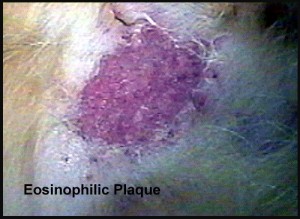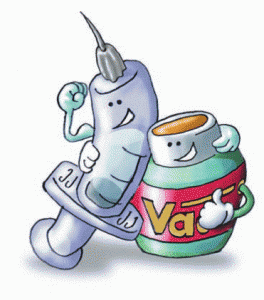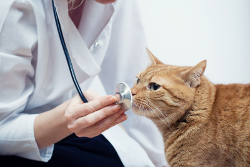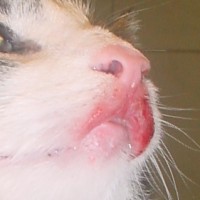Rodent ulcers, also known as indolent ulcers, are unique to cats. Despite their name, there is no connection between them and rodents of any kind. The term “rodent ulcer” came from the old belief that the sores were from a rodent bite or some sort of infection the cat caught from a rodent. Even though the veterinary community now knows this is not the case, the name has stuck.
So What Are They?
 A rodent ulcer starts as a pinkish spot, usually around the cat’s mouth and develops into an open sore. They most commonly present on the upper lip but can also occur on the bottom lip, tongue, or behind a molar. They seem to cause no pain. The cat will often not give any notice to the presence of a rodent ulcer.
A rodent ulcer starts as a pinkish spot, usually around the cat’s mouth and develops into an open sore. They most commonly present on the upper lip but can also occur on the bottom lip, tongue, or behind a molar. They seem to cause no pain. The cat will often not give any notice to the presence of a rodent ulcer.
As it advances, the ulcer may begin to partly erode the lip and cause swelling. Rodent ulcers are grouped into a larger disease called “feline eosinophilic granuloma complex”. This group of feline skin disorders also includes:
- Eosinophilic Plaques: Lesions that usually present on the abdomen and thighs.
- Eosinophilic Granulomas: Linear, inflamed lesions found on the caudal thighs, tongue, palate and other areas of the face.
All of these often have the same effect on the cat. They can all be treated with the same therapy, and usually have the same underlying cause.
What Causes Rodent Ulcers
These ulcers can develop in cats of all ages but are three times more common in females than males. The exact cause is often never known but there is evidence that points to some cats having a predisposition to developing these types of ulcers. There are also studies that point to various other causes. As of right now, veterinarians tend to treat these ulcers based on three common causes:
- Allergies: Most commonly, an allergy is present. This could be an allergy to fleas, food, or other things in the cat’s environment such as plastic or rubber food dishes.
- An Autoimmune Reaction: Some studies attribute the ulcers to an autoimmune reaction. This type of reaction occurs when the body considers a part of itself as a threat and the immune system attacks a portion of the body.
- Genetics: Other studies indicate that there may be some genetic origin.
In some cases, rodent ulcers have been seen in cats that have been exposed to the feline leukemia virus. This further implies that an impaired immune system may play a role in the formation of these types of ulcers. However, that does not mean that all cats with rodent ulcer have feline leukemia. It has only been observed in some cases. In any case, your cat will be tested for the feline leukemia virus.
How Rodent Ulcers Are Diagnosed
The attending veterinarian can diagnose a rodent ulcer simply by observing the typical appearance and location of the ulcer. In rare cases, needle aspirate cytology or a biopsy is done to rule out malignancy. This is especially the case in a recurring ulcer or one that does not respond to treatment.
How Rodent Ulcers Are Treated
 Treatment usually consists of steroid therapy. Cortisone along with antibiotics has proven to be one of the most effective treatments. The antibiotic clears up any bacterial infection while the cortisone subdues the ulcer. There are two common methods of administering cortisone:
Treatment usually consists of steroid therapy. Cortisone along with antibiotics has proven to be one of the most effective treatments. The antibiotic clears up any bacterial infection while the cortisone subdues the ulcer. There are two common methods of administering cortisone:
- Orally (prednisone): A pill that is usually given on a daily basis until the ulcer clears up.
- Injection (Depo-medrol): Three courses given at two-week intervals.
Treatment for Underlying Flea Allergies
If an allergy is the suspected cause for a rodent ulcer, such as a flea allergy, your veterinarian will recommend a flea treatment and preventative.
Treatment for Underlying Food Allergies
If your cat is already on a flea preventative and the cause is most likely a food allergy, a change in food would be most beneficial. Some cats are allergic to wheat, while many are allergic to chicken. A simple change in food could bring some much-needed relief. Your veterinarian will discuss how to go about a food allergy trial and may also write a prescription for some special food.
Treatment for Environmental Allergies
In the case of a rodent ulcer, it always best to switch your cat’s dishware if she’s using plastic or rubber bowls. These types of bowls commonly cause allergic reactions in cats. Stainless steel is an alternative option that does not tend to cause allergic reactions.
Treatment for Seasonal Allergies
Additionally, some cats seasonally present with rodent ulcers, similar to the way some people suffer from hay fever in spring or other portions of the year. In these cases, a maintenance regimen of prednisone may be prescribed during peak months.
Allergies Are Nothing to Sneeze At
It’s important for you and your veterinarian to try and find the allergen and eliminate it, otherwise the rodent ulcer may recur and continue to recur for the remainder of your cat’s life.
Tips for Possible Prevention
As far as prevention of rodent ulcers goes, it is difficult if you are not aware of the underlying cause. If your cat has a known allergy, take all measures to eliminate it. Otherwise, keep your cat on flea and parasite prevention, make sure she is eating healthy, nutritious food, and aid her in her grooming. Always keep an eye out for any behavior that may indicate an allergy and alert your veterinarian. Some things to look for are:
- Vomiting
- Diarrhea
- Sneezing
- Bald patches
- Excessive grooming
Thanks for visiting www.catdandruffclinic.com, if you liked this article please like us using the side bar .
Related Posts:



Comments are closed.